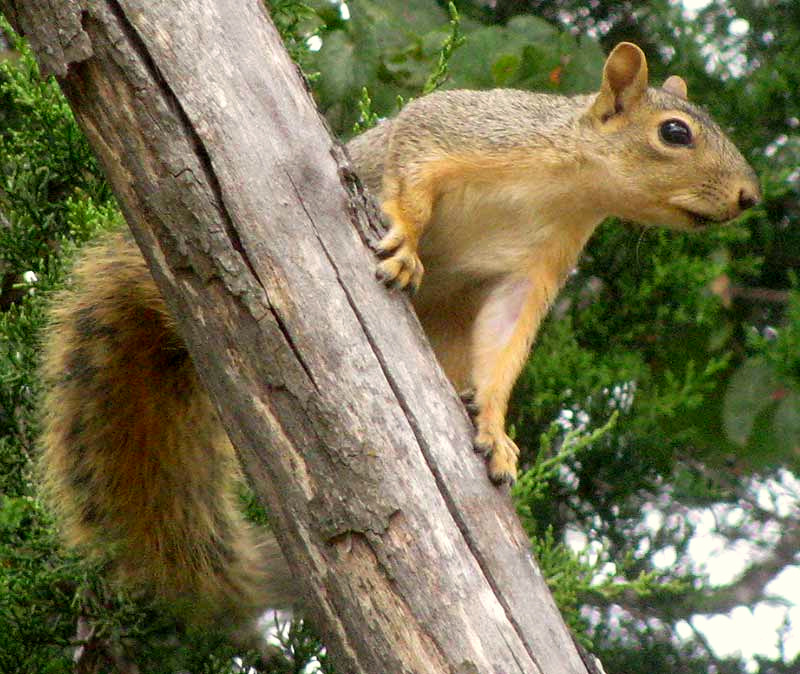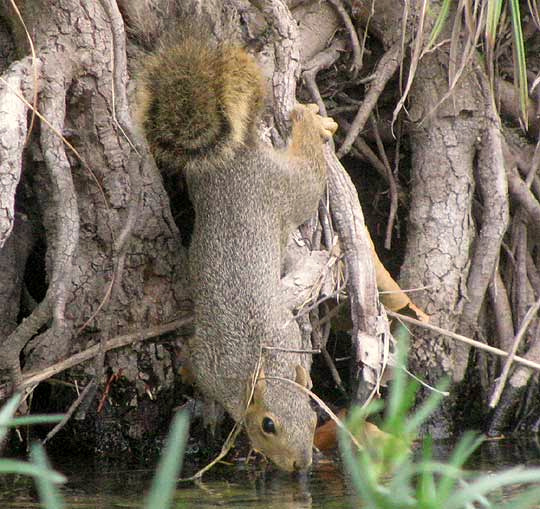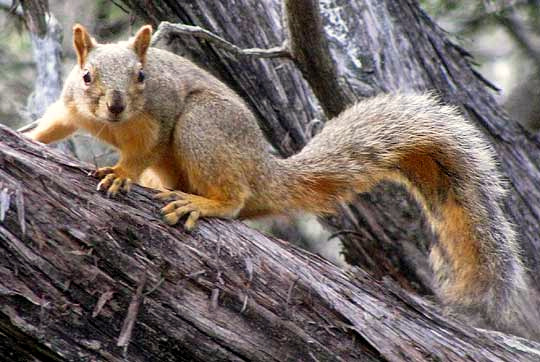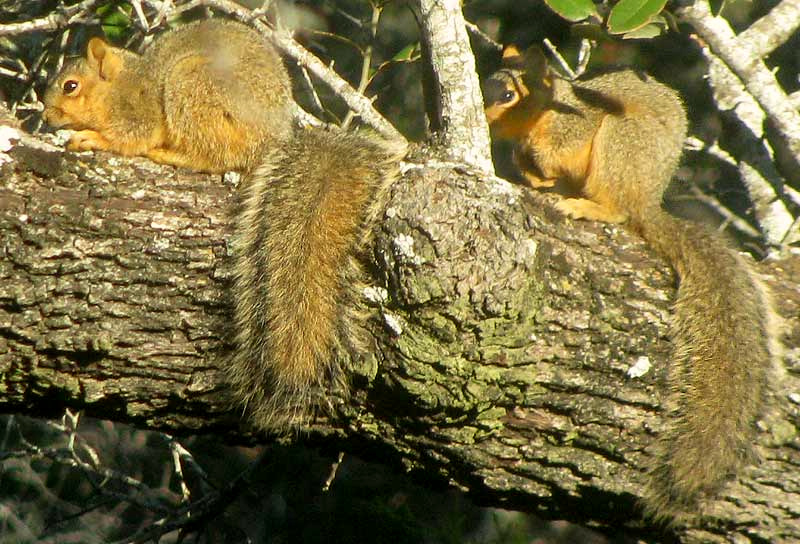Excerpts from Jim Conrad's
Naturalist Newsletter

from the September 9, 2012 Newsletter issued from the valley of the Dry Frio River in northern Uvalde County, southwestern Texas, on the southern border of the Edwards Plateau; elevation ~1750m (~5750 ft); N29.62°, W99.86°; USA
THIRSTY FOX SQUIRREL
Maybe a hundred yards (meters) behind the cabin, clear water runs about ankle deep across the Dry Frio River's flat, limestone bed. I was sitting on a little island of cobblestones in midstream when a large, rusty-tinged squirrel came sneaking through the streamside bushes, keeping to the shadows and being careful. Stealthily he moved behind a big sycamore with roots plunging directly into the water. After awhile the squirrel peeked from behind the tree, then moved around to the water side, and did what you see below:

After a good slurp the squirrel scampered up the sycamore and when he reached a dead snag high enough to feel safe he paused and looked around, as you can see at the top of this page.
The large size and all that rustiness on the underparts -- in the tail and on the ears and eyes -- mark this as an Eastern Fox Squirrel, SCIURUS NIGER, not the usual gray squirrel of eastern parks and woodlots. Eastern Gray Squirrels don't naturally occur this far west, though they've been introduced here and there far beyond their native range. We are well within the Eastern Fox Squirrel's natural distribution, however, which is practically all of the eastern Half of the US except for New England, most of New York, Pennsylvania and New Jersey. In our area they extend across the Rio Grande into Mexico, but just barely. However, they also have been introduced far beyond their natural range so you can't depend on distribution maps for identification purposes.
I've seen several fox squirrels here, and well I should, since Texas Live Oaks with their large acorns are abundant.
from the December 8, 2013 Newsletter issued from the Frio Canyon Nature Education Center in the valley of the Dry Frio River in northern Uvalde County, southwestern Texas, on the southern border of the Edwards Plateau; elevation ~1750m (~5750 ft); N29.62°, W99.86°; USA
CRAZY SQUIRRELS
About mid slope on the hill where Juniper House sits, funny-sounding grunts, clucking and high-pitched chortling issued from treetops. It was half a dozen Fox Squirrels -- five males chasing a female in heat.
They were all behaving in a way that common-sense, everyday squirrels never would. The males acted as if they were crazy, or drunk, scrambling after the female so blindly that consistently they misjudged their footing and ran into limbs, knotholes and one another, sometimes falling on their faces, and one even tumbled from the tree onto the ground, but got up and returned to the chase so fast he didn't even seem to notice that he'd fallen.
During the chases the squirrels were so reckless and absorbed in what they were doing that they didn't seem to notice me moving around below them. One got so close that I could have reached out and touched him. Another, on an Ashe Juniper trunk, was so close I had to step back to get him all in my camera's view finder. When he noticed me he stared in such a way that suggested he realized that something was amiss, but he couldn't figure out what, and, judging by how quickly he then continued the chase, couldn't be bothered with it. Below, you can see him at the moment he was staring at me:

Up in the trees, the female would reach the end of a branch, turn around and scream a kind of babbling reproach or threat that kept the males at bay. But then she'd rush past them and they'd chase her again, one tree after another, around and around. As Jerry Wolff and Paul Sherman say in their 2008 book Rodent Societies: An Ecological and Evolutionary Perspective, browsable via Google Books, "The spatial and temporal dispersion of estrous females provides challenges to males."
Wolff and Sherman say that among well populated Fox Squirrel communities, when chases like this take place, the chasing males fall into two groups. Somewhat less than half the males are older, higher ranked ones competing to mate with the female, while the other males are younger, lower ranked ones who chase with less enthusiasm, and during the chase may take time out to feed or simply to rest.
The chase's evolutionary benefit is clear: The male who is fit enough to outlast or out-maneuver the others passes along his genes.
The situation isn't completely black and white, though. Sometimes when a female breaks away from the higher ranked males, a younger, lower ranked "satellite" individual may sneak in and mate with her. During a chase, the female may mate with several males; Among Gray and Red Squirrels, multiple paternity of litters has been confirmed.
Also, there's the matter of "copulatory plugs," which are common among rodents, including tree squirrels such as our Fox Squirrels. The plug forms after mating. Male Fox Squirrels guard the female for about an hour and a half, preventing other males from access to her. But female Fox Squirrels have been observed removing and eating or discarding their plugs about 75% of the time.
Beyond all this, it's assumed that inside the female the sperm, perhaps from multiple partners, compete among themselves to be the one who fertilizes the egg.
from the May 18, 2006 Newsletter issued from Polly's Bend, Garrard County, in Kentucky's Bluegrass Region, USA
A ROLY-POLY FOX SQUIRREL
The other day I looked out the kitchen window and saw an Eastern Fox Squirrel, SCIURUS NIGER, rolling on the ground beneath the big elm tree. He was uncommonly rusty red and so fat and glossy his skin rippled when he moved. His face was so round that I suspected his cheeks were crammed with food, but after a while I decided that he just had fat cheeks. When he looked toward the house, his face seen head-on reminded me of a walrus's.
While planting some hostas at the base of the elm I'd scalped away turf and left plugs of grass lying around. Now the grassy plugs had dried out so that they looked like brown, bristly sea-urchins. The funny thing was that this fox squirrel was irresistibly attracted to the plugs.
One brown, stubbly plug after another this squirrel would sniff, rub his face against, and finally wrap his flabby body entirely around, making a ball of himself, and then he and the plug would roll downslope for a couple of feet. That squirrel was clearly enjoying a sensuous experience with the dried-out, dead-grass clods, but I couldn't figure out whether he was just playing, or doing something kinky. The more I watched, one plug after another, the more I began thinking that maybe he was making love to those things.
I can't explain what I saw. Eventually, after visiting all the clods, he loped unhurriedly across the lawn and disappeared into the hayfield.
When I see something like that I realize how little about plants and animals I really know. I just can't say whether in watching that squirrel I've seen a fellow mammal spontaneously and innovatingly playing, or rather a fellow mammal so enslaved to the tyranny of his hormones that when he came across a furry clod where a female earlier had rested leaving her scent, he just had to make love, no matter how ugly and unresponsive his partner was.
I'd like to know the answer to that question because as I look back on my own life I'm not really sure to what extent I myself have been spontaneously innovative, or hormonally enslaved. The more I think about my most spontaneous moments, the more they seem the urgings of hormones. But the more I think about my most kinky exploits, the more delightfully unrestrained and free I remember myself as being. There seems to be a kind of paradox here summed up in the squirrel's head-on, walrus-like facial expression.
I guess the only thing certain about both of us is that we probably looked pretty funny while we were rolling around doing whatever it was we were doing.
from the December 29, 2013 Newsletter issued from the Frio Canyon Nature Education Center in the valley of the Dry Frio River in northern Uvalde County, southwestern Texas, on the southern border of the Edwards Plateau; elevation ~1750m (~5750 ft); N29.62°, W99.86°; USA
BASKING FOX SQUIRRELS
On recent chilly but sunny mornings two or three Fox Squirrels usually could be seen basking in the sun, their bodies perpendicular to the incoming rays and their luxuriously fuzzy tails deployed over the side of a liveoak's leaning trunk. You can see a pair hard at it below:
